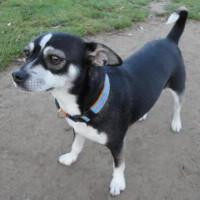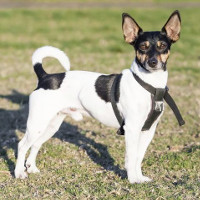 |
Rat-Cha |
|
He is not recognized by the F.C.I. |
Origin |
U.S.A. <> Mexico -> U.S.A. | |
Translation |
Francis Vandersteen |
A brief presentation of the Rat-Cha |
| The Rat-Cha is a cross between the purebred Rat Terrier and the purebred Chihuahua. This creative dog has lots of energy and is very affectionate towards its family. The Rat-Cha, also known as the Rat-Chi, is frisky and can be overprotective of its people. Owners can prevent aggressive or undesirable protective traits by socializing early with people, places and other dogs. This cute, perky mix of Rat Terrier and Chihuahua tends to bond with one person in the family, and will spend much of its time on that person's lap. |
History of the Rat-Cha |
| The Rat-Cha is a popular designer breed due to the great popularity of both parent breeds. Despite the puppy's popularity, detailed accounts of their breeding programs and history are not available. This is probably due to the recent hybridization of the two parent breeds and the number of variations that may be present in the offspring of the Rat Terrier and Chihuahua mix. Pet parents wishing to understand the histories and potential traits of their Rat Terrier and Chihuahua mix can examine those of both parents to find out more. |
A little of the Rat Terrier |
||
| The Rat Terrier is a long-standing American breed. The breeding program included several other well-established breeds, such as the Manchester Terrier, Bull Terrier, Old English White Terrier and Fox Terrier. The aim of the breed programs was to produce a small type of Terrier that was a tenacious rat dog and could be found in cramped quarters. Despite its belated recognition by the American Kennel Club in 2013, the Rat Terrier has long been bred in the USA. A Rat Terrier appeared alongside Shirley Temple in The Little Colonel and was the Terrier of choice for President Theodore Roosevelt, who wanted a rat dog to manage the rat problem at the White House. The Rat Terrier also varied in the USA depending on the region it came from. In the South, the Rat Terrier was crossed with the Beagle to produce a pack-minded rat dog, while the Greyhound and Whippet breeds were used in the Midwest to give the Rat Terrier fleet capabilities against fast hares. | ||
 |
||
| Presentation of the Rat Terrier |
A little of the Chihuahua |
| The Chihuahua is also a dog of the Americas, but originally from Mexico. Accounts of the Chihuahua, then known as the Techichi, date back to the 9th century in the Mesoamerican region, where the little dogs were bred as both vermin hunters and companions. Techichi were so beloved that they were often buried alongside their masters upon death. Techichi fell into obscurity during the Spanish invasion of the Aztec state, but the resilient little dog persisted in the region and was rediscovered living in the Mexican state of Chihuahua in the mid-1800s, where the breed acquired its new name. Shortly after their rediscovery, the Chihuahua made its way to the northern United States in the late 1800s, and the American Kennel Club recognized the breed in 1904. Interest in the Chihuahua grew rapidly and, by the 1960s, the Chihuahua was considered one of the most popular dogs in the country. Today, the Chihuahua still enjoys a highly popular ranking in the American Kennel Club. |
 |
| Standard of the Chihuahua |
Appearance of the Rat-Cha |
| The Rat-Cha can vary considerably in appearance, not because the parents are very different, but because there are variations in the standards of the parent breeds. However, this hybrid is sure to be small with longer hair. Their head is small and round, with large, upstanding, triangle-shaped ears. The eyes are dark, round and prominent, but not as bulging as the eyes of the parent Chihuahua. Both parent breeds suffer from dental problems, and this small-mouthed puppy may have missing teeth or poor dentition, such as an underbite, which are not desirable traits. The body is compact and long, with slender legs and a short to medium stiff tail. |
Temperament of the Rat-Cha |
| The Rat-Cha is an affectionate companion, usually bonding with one person in the family. They require early socialization to reduce aggression towards strangers and are not suitable for young children. They have lots of energy but prefer activities on their own terms rather than being forced to play. Often, this cuddly dog is perfectly content in its owner's lap. They don't have a pack mentality and prefer to be single dogs living under the same roof. However, with socialization, they can learn to live in harmony with other dogs. Prey drive can make life with cats more difficult, but socialization will also help. Home training the Rat Terrier and Chihuahua mix is relatively easy, given the breed's small size. This is attributed to the puppy's great intelligence and desire to please his master. |
Needs and activities of the Rat-Cha |
| The Rat-Cha is an active, high-energy hybrid. However, activities often come in short bursts, and this miniature companion can do most of its daily exercise at home. They are very adaptable to small living spaces, but a small yard where they can run and jump is ideal for this creative dog. They should not be left alone outside, and do not tolerate being alone for long periods. They can develop negative behaviors, such as chewing or digging if they're bored or lonely. The Rat Terrier/Chihuahua mix doesn't do well in cold environments and prefers warmer ones. However, this breed can live just about anywhere, as it will spend most of its time in an air-conditioned home. |
Maintenance of the Rat-Cha |
| The Rat-Cha is an easy-care dog with minimal grooming needs. They are moderate shedders, and weekly brushing will help remove any excess loose or dead hairs. They are not hypoallergenic, but weekly grooming will help reduce allergens. The Rat-Cha is not known for having a doggy smell, so any foul odor may indicate a health problem, such as an ear infection or dental problems. This little dynamo is prone to developing dental problems, many of which can be avoided by keeping their teeth clean. Owners can help their dogs maintain a healthy mouth by brushing frequently and providing hard, rubberized chew toys. |






 English (United Kingdom)
English (United Kingdom)